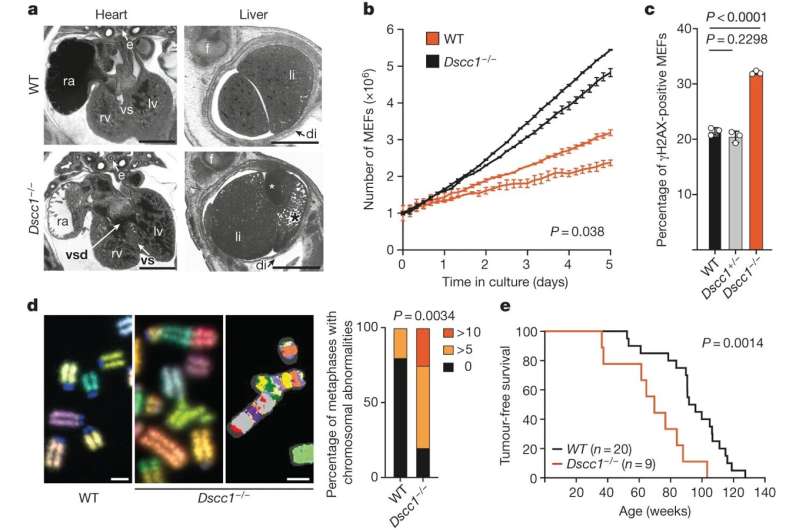This article has been reviewed according to Science X's editorial process and policies. Editors have highlighted the following attributes while ensuring the content's credibility:
fact-checked
trusted source
proofread
Key genes linked to DNA damage and human disease uncovered

More than one hundred key genes linked to DNA damage have been uncovered through systematic screening of nearly 1,000 genetically modified mouse lines in a new study published in Nature.
The work provides insights into cancer progression and neurodegenerative diseases as well as a potential therapeutic avenue in the form of a protein inhibitor.
The genome contains all the genes and genetic material within an organism's cells. When the genome is stable, cells can accurately replicate and divide, passing on correct genetic information to the next generation of cells. Despite its significance, little is understood about the genetic factors governing genome stability, protection, repair, and the prevention of DNA damage.
In this new study, researchers from the Wellcome Sanger Institute and their collaborators at the UK Dementia Research Institute at the University of Cambridge set out to better understand the biology of cellular health and identify genes key to maintaining genome stability.
Using a set of genetically modified mouse lines, the team identified 145 genes that play key roles in either increasing or decreasing the formation of abnormal micronuclei structures. These structures indicate genomic instability and DNA damage, and are common hallmarks of aging and diseases.
The most dramatic increases in genomic instability were seen when the researchers knocked out the gene DSCC1, increasing abnormal micronuclei formation five-fold. Mice lacking this gene mirrored characteristics akin to human patients with cohesinopathy disorders, further emphasizing the relevance of this research to human health.
Using CRISPR screening, researchers showed this effect triggered by DSCC1 loss could be partially reversed through inhibiting protein SIRT1. This offers a highly promising avenue for the development of new therapies.
The findings help shed light on genetic factors influencing the health of human genomes over a lifespan and disease development.
Professor Gabriel Balmus, senior author of the study at the UK Dementia Research Institute at the University of Cambridge, formerly at the Wellcome Sanger Institute, said, "Continued exploration on genomic instability is vital to develop tailored treatments that tackle the root genetic causes, with the goal of improving outcomes and the overall quality of life for individuals across various conditions."
"Our study underscores the potential of SIRT inhibitors as a therapeutic pathway for cohesinopathies and other genomic disorders. It suggests that early intervention, specifically targeting SIRT1, could help mitigate the biological changes linked to genomic instability before they progress."
Dr. David Adams, the first author of the study at the Wellcome Sanger Institute, said, "Genomic stability is central to the health of cells, influencing a spectrum of diseases from cancer to neurodegeneration, yet this has been a relatively underexplored area of research."
"This work, 15 years in the making, exemplifies what can be learned from large-scale, unbiased genetic screening. The 145 identified genes, especially those tied to human disease, offer promising targets for developing new therapies for genome instability-driven diseases like cancer and neurodevelopmental disorders."
More information: David Adams, Genetic determinants of micronucleus formation in vivo, Nature (2024). DOI: 10.1038/s41586-023-07009-0. www.nature.com/articles/s41586-023-07009-0





















